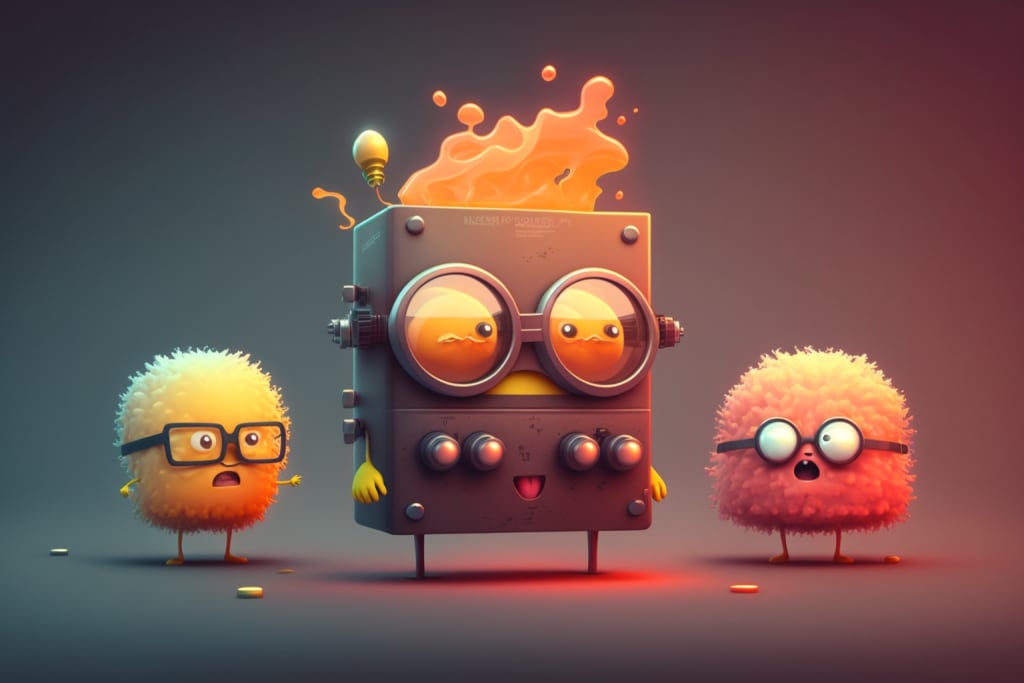What is the Difference between AI and Automation?
How do they fit together?

Sponsored by AI-Info.org
The advancement of technology is revolutionizing the way we think about, use and interact with computers. We are now living in an age where artificial intelligence (AI) and automation are becoming more and more integrated into our lives. But what exactly is the difference between AI and automation? Do they have separate applications or can they be used together to create a smarter, more efficient system? In this article, we will explore these questions and examine the differences between AI and automation.
First off, let’s define both terms. Automation refers to any task that requires minimal human intervention such as robotic process automation (RPA). On the other hand, AI involves machines learning from data sets to autonomously improve themselves over time without requiring direct programming by humans. With automated systems, tasks are structured and programmed according to predetermined rules while in AI-based systems, algorithms learn from their environment so as to make better decisions on how to act within it.
Finally, when it comes down to how each type of technology affects our daily lives, there is no one answer since both types of systems offer benefits depending on your specific needs. For instance, if you need something done quickly then an automated system may be best for you whereas if you want something done more intelligently then an AI system might suit you better. Ultimately though, understanding the differences between AI and automation will help us determine which solution works best for our particular situation.
What Is Artificial Intelligence
AI is like a breath of fresh air, transforming the way we think about automation and creating a world of endless possibilities. It’s an exciting field that combines human intelligence with computer science to create systems capable of solving complex problems without requiring explicit instructions from people. AI can be thought of as machines learning how to think for themselves, using data analysis and pattern recognition to identify trends in information or make decisions on its own. Examples include natural language processing (NLP) – understanding spoken and written language; robotics – robots controlled by computers that can sense their environment; machine vision – allowing machines to recognize objects, faces, and gestures; and more. By leveraging AI technology, businesses are able to automate mundane tasks and achieve greater efficiency with fewer resources. This has been proven time and again in industries ranging from healthcare to finance.
The difference between AI and automation lies in the level of complexity involved in each task. Automation involves carrying out predetermined processes through mechanical means while AI entails training algorithms so they can learn patterns within datasets and apply them to new scenarios. While both use machines to complete tasks quickly at scale, only AI deals with problem-solving through self-learning capabilities which allows it to adapt over time instead of following preset steps every time. With this extra layer of sophistication comes great potential for innovation but also higher costs due to the intensive research required for developing customized solutions for specific needs. As opposed to basic automation tasks where the desired outcome is obvious, the outcomes stemming from AI initiatives remain unpredictable until implemented — making them riskier investments yet potentially more rewarding too.
What Is Automation
Automation is a powerful tool that has revolutionized many industries. It can be defined as the process of using technology to automate certain tasks and processes, allowing people to save time and effort while accomplishing more in less time. Automation can range from simple programs such as macros used for data entry purposes to complex systems that are capable of managing entire companies or organizations with an automated workflow. By making use of sensors, computers, and other advanced technologies, automation allows machines to monitor their environment and take appropriate actions based on pre-defined parameters.
At its core, automation involves taking tedious or repetitive manual labor out of the equation so humans can focus on higher priority tasks or activities. This type of automation also offers numerous advantages over traditional methods by saving money in terms of labor cost and increasing efficiency across various areas within an organization. Additionally, it improves scalability by enabling businesses to scale up operations without having to hire additional personnel.
The benefits offered by automation make it increasingly popular among both startups and established companies alike who seek better ways to operate their businesses efficiently at lower costs. Overall, automation provides significant value when properly implemented into existing workflows – freeing up resources for employees to concentrate on more critical aspects of their job roles. With this newfound freedom comes greater opportunities for innovation which leads us into our next topic: How are AI and automation related?
How Are AI And Automation Related
The relationship between artificial intelligence (AI) and automation is like a high-tech jigsaw puzzle. The individual pieces of the puzzle – AI and automation – are both essential to creating the complete picture, but they don’t work together in quite the same way. Automation refers to machines or processes that run automatically without any human intervention. It’s used to speed up certain tasks or streamline entire systems, such as assembly lines in manufacturing plants. On the other hand, AI is an umbrella term for a variety of technologies that allow computers and machines to replicate human behavior by understanding language, recognizing images, making decisions and carrying out complex tasks autonomously. While these two concepts may seem unrelated at first glance, they actually complement each other perfectly.
Automation deals with reducing manual labor while AI focuses on increasing machine efficiency. By combining these two elements, organizations can improve their productivity significantly and reduce costs associated with production or customer service tasks. With automated technology taking care of mundane tasks quickly and accurately, humans can devote more time to focusing on creative problem solving or higher value activities instead. Through this process of leveraging both automation and AI capabilities simultaneously, businesses are able to gain a competitive advantage over their lesser-equipped rivals as well as create opportunities for innovation that were never before possible.
As we look ahead towards the future of business operations it is clear that utilizing advanced technologies like AI and automation will be critical for staying ahead of competitors in our increasingly digital world. To truly maximize their benefits though requires us to understand how they interact with one another so we can use them effectively in tandem rather than separately
to create a powerful and efficient digital workflow that can help our business succeed.
What Are The Benefits Of AI And Automation
AI and automation have become increasingly popular in the workplace, with employers expecting to invest over $232 billion into AI technology by 2021.1 With such a huge investment being made, it’s not surprising that many businesses are interested in learning more about what benefits these technologies can bring.
One of the biggest advantages of using AI and automation is improved productivity. Automated processes reduce the amount of manual labour required for tasks like data entry or customer service, allowing employees to focus on higher-value activities instead. By automating mundane tasks, companies can also improve accuracy and consistency while reducing errors from human input. Additionally, automated systems allow organizations to leverage real-time analytics which can be used to spot trends faster and make informed decisions quickly.
Another advantage of utilizing AI and automation is cost savings. Automation helps cut down labor costs since fewer people are needed for repetitive jobs. It also reduces operational expenses since machines don’t require breaks or sick days like humans do. And because they work around the clock without getting tired, businesses can save money on energy bills as well as production time compared to manual operations.
Finally, AI and automation offer opportunities for enhanced customer experiences. By leveraging machine learning algorithms and natural language processing (NLP) capabilities, companies can provide customers with personalized recommendations tailored just for them based on their preferences or past purchases. This type of personalization allows businesses to better understand customers’ needs and build stronger relationships with them — something that would be much harder if done manually.
The potential benefits of integrating AI and automation into business operations are clear — but there may still be some challenges involved too…
What Are The Challenges Of AI And Automation
Let’s face it, AI and automation are all the rage these days. Everyone seems to think that by automating our lives with robots and intelligent machines, we’ll finally reach a utopia where everything is perfect! But what about the drawbacks? What are some of the challenges associated with implementing AI and automation into our everyday lives?
For starters, there’s an ethical issue when it comes to both AI and automation. Who gets to decide how exactly they should be used – and for whose benefit? Issues of privacy also come up; when do automated systems cross the line from being helpful to becoming intrusive? Not only that but if a system malfunctions or fails completely, who takes responsibility — people or machines?
Another major challenge has to do with cost. Investing in AI isn’t cheap, so those without big budgets may find themselves at a disadvantage here. Additionally, many companies have difficulty finding qualified professionals who understand the complexities of working with artificial intelligence. And while there are tools available to make this easier, they often require significant training before anyone can use them effectively.
But perhaps the most difficult problem lies within ourselves: humans struggle with trusting something as powerful (and potentially dangerous) as AI or automation technology. We want assurance that any automated system will protect us instead of taking advantage of us—a guarantee that’s hard to provide given how quickly new technologies emerge.
So yes, AI and automation can bring great opportunities for innovation and convenience – just not without its own set of issues first! It remains up to us as individuals to weigh out their potential risks against rewards before deciding whether embracing these technologies is worth it for us personally or professionally.
Conclusion
In conclusion, AI and automation are two technologies that have made a big impact on our lives. They both offer great benefits but also come with their own set of challenges. While they may seem similar at first glance, there are distinct differences between the two. AI is more focused on problem solving, while automation focuses on streamlining processes. It’s like comparing apples to oranges: both delicious in their own way, but each offering something unique.
For businesses looking to make the most out of these technologies, it’s important to understand how they can be used together for maximum efficiency and productivity. By leveraging the power of both AI and automation, companies can take advantage of greater cost savings with minimal effort and time investment. With this understanding, organizations will continue to reap the rewards of these powerful tools and pave the way for a more efficient future.
About the Creator
Patrick Dihr
I'm a AI enthusiast and interested in all that the future might bring. But I am definitely not blindly relying on AI and that's why I also ask critical questions. The earlier I use the tools the better I am prepared for what is comming.






Comments
There are no comments for this story
Be the first to respond and start the conversation.